Context:
- The Sacred Bowl of Buddha
- Uruk bowls
- Buddhism and land of the pure
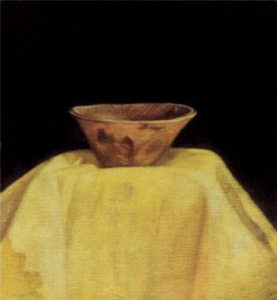 Buddha Gautama was born in India. His universal teaching still influences the country. The central motif of the Indian flag is the Buddhist spinning wheel or Ashoka Chakra. This Dharma chakra is placed on the Sarnath Capital of the Buddhist emperor Ashoka (Sanskrit: Asoka). See village Osokino in Yaroslavl region. Asoka’s lion capital from Sarnath is the official Emblem of India. Sarnath was the place where Buddha gave his first sermon after attaining enlightenment. By law, Indian flag is to be made of a special type of hand-spun cloth or silk, made popular by the father of Indian nation Mahatma Gandhi. Also see Sections IV and V. His ideas are very close to the ones of Buddha.
Buddha Gautama was born in India. His universal teaching still influences the country. The central motif of the Indian flag is the Buddhist spinning wheel or Ashoka Chakra. This Dharma chakra is placed on the Sarnath Capital of the Buddhist emperor Ashoka (Sanskrit: Asoka). See village Osokino in Yaroslavl region. Asoka’s lion capital from Sarnath is the official Emblem of India. Sarnath was the place where Buddha gave his first sermon after attaining enlightenment. By law, Indian flag is to be made of a special type of hand-spun cloth or silk, made popular by the father of Indian nation Mahatma Gandhi. Also see Sections IV and V. His ideas are very close to the ones of Buddha.
In the East, the co-called Buddha’s Bowl is revered as the greatest shrine. The Bowl ‘came’ to Roerichs in 1934, when they lived in Kullu (India). In the same miraculous way, while living in Paris, they got in 1923 the Stone of Chintamani, well known in Buddhist and Hindu traditions.
Moving along the Earth, these sacred artifacts find themselves in places that are the centers of evolutionary work, coming to different people at different epochs — the Great Bearers of the Instructions of the Brotherhood of Teachers (Shambhala).
The Doctrine of Living Ethics written by Elena Roerich in co-operation with the Brotherhood, states that the true meaning of the symbol of the Bowl is the acceptance and accumulation of spiritual gifts that are used to serve the world.
Her son Svyatoslav Roerich was the last of the known keepers of the Buddha’s Bowl. He dated its age from 10 000 to 12 000 years and indicated that the bowl had a water pattern that could be related to the sign of Aquarius. Mankind is entering the Age of Aquarius, which should become a long-awaited Golden Age for the planet.
The only city on Earth that has Aquarius on its coat of arms is Veliky Ustyug located nearby above mentioned Northern Ridge (Severnyye Uvaly), the proposed homeland of the Aryans who moved to India and Iran few thousand years ago.
Kuru was a powerful Indo-Aryan tribal union and kingdom during the Vedic period. According to Hindu mythology, Kuru was the ancestral king of Indo-Aryan Kuru tribe.
Read from the right to the left, the king’s name Kuru gives Uruk that is the name of a Sumerian city. Interestingly, in Sumerian the word ‘kur’ meant hill or country.
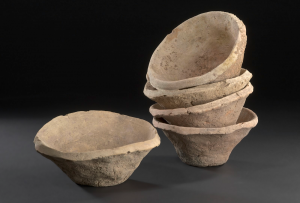 Uruk in Southern Iraq is credited as the first known city of the present civilization. So, Uruk is the parent of all modern cities. The estimated age of Uruk is around 6000 years. The ceramics of Uruk and its colonies have striking similarity the above mentioned Buddha’s Bowl.
Uruk in Southern Iraq is credited as the first known city of the present civilization. So, Uruk is the parent of all modern cities. The estimated age of Uruk is around 6000 years. The ceramics of Uruk and its colonies have striking similarity the above mentioned Buddha’s Bowl.
Uruk played a leading role in the early urbanization and state formation. It was the largest city in the world. It suddenly shifted from small, agricultural villages to a larger urban center with a full-time bureaucracy, military, and stratified society. An appealing hint is given in the Middle East mythology and legends. The gods or highly developed civilization from Nibiru might be responsible for such instant and dramatic change of human evolution.
Before Uruk became urban it was the first sanctuary of the sky god Anu (An) called E-anna (house of heavens). In this sanctuary (later Uruk), the Nibiruans made important decisions on the construction of new cities in Mesopotamia. Anu (An) was the ruler of Nibiru and stayed in this place during one of his visits to Earth. Later Anu (An) gave this sanctuary to his beloved grand granddaughter Inanna (Ishtar). She was the goddess of love, fertility, war, and political power, etc. During the reign of Inanna (Ishtar) Uruk turned into one of the richest urban centers of Mesopotamia. Here she founded the custom of the ‘Holy Marriage’, which became part of the ancient world, when for one night the king-priest became her husband.
The legendary king and semi god Gilgamesh was the fifth ruler of Uruk. He is the main character in the Epic of Gilgamesh that is considered the first great work of literature. For instance, the Epic of Gilgamesh contains the story of the Biblical Great Flood and the sage Utnapishtim who survived it. The epic describes Gilgamesh’s refusal to participate in Ishtar’s fertility union described above.
The Ishtar Gate of Babylon was the central route of their New Year festival that later has become the Easter. Russia’s New Year capital is the above mentioned town Veliky Ustyug near the proposed homeland of the Aryans.
Nagar (Tell Brak)
Among the most distant colonies of Uruk was Nagar in modern Syria. The city’s original name is unknown. Tell Brak is the name of the nearest village and archeological site. During the second half of the third millennium BC, the city was known as Nagar and later on, Nawar. Read from the right to the left, Nawar is Rawan. Ravana is the main antagonist in the ancient Hindu epic Ramayana. See the Ravan River in Leningrad region of Russia. Russian word ‘nawar‘ means brew, profit, etc. Also, Warka is a town in central Poland, 60 km. from its capital Warsaw. Polish Warka is known for its famous brewery. Warka is the Arabic name of Mesopotamian Uruk (Nagar’s former metropolis). In Sanskrit, ‘var’ means water and protector; vara means ‘best’, etc. Well known is the fact of Arian migration from the Russian plane toward the Middle East, Mesopotamia, Iranian Plato and Indian subcontinent.
Nagar is a Hindu word for city, town, urban. In Sanskrit, ‘nagara’ means city, urban and ‘sura‘ means sun, deity, etc. See Sura River in Ulyanovsk region of Russia.
Sher Shah Suri (1486 – 1545) was the founder of the Sur Empire in North India, with its capital at medieval Delhi that is based on the territory of seven ancient cities. Moscow based on the seven hills is twin city of Delhi. There are many Sanskrit names in Central Russia. See Sanskrit names in Moscow region and village Deli in Tver region mentioned in the Section I of this article.
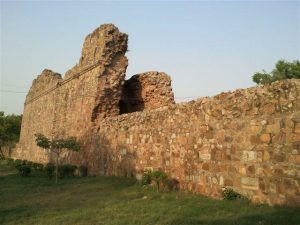
Siri Fort, New Delhi
One of the Delhi’s ancient cities is Siri, located few kilometers from the modern Qutab Minar and the much older Iron Pillar. The adjoining township is known as Mehrauli named after the famous astronomer Mihira of the legendary Indian emperor Vikramaditya (‘the Sun of Valour’ or ‘Brave as the Sun’). It is said that Mihira had here an astronomical tower that was converted the world famous minaret and one of Delhi’s symbols. The Qutub Minar at Delhi is the tallest brick minaret (73 m.) and a UNESCO World Heritage Site. Its design is thought to have been based on the Minaret of Jam (65 m.), located on the river Hari (~1100 km.) in Afghanistan. In Sanskrit, ‘hari’ means ‘Sun’ that is also connected with the above mentioned Vikramaditya.
Vikramaditya’s name has been given to Indian Navy’s aircraft carrier INS Vikramaditya dedicated it to the Indian nation. It has been modified from Russian aircraft carrier Admiral Gorshkov. Surname Gorshkov comes from the Russian word ‘gorshok’ meaning a pot or kumbha (Sanskrit). Vikramaditya’s capital was at Ujjain that is one of the four places of the Kumbh Mela.
Aquarian with two pots (kumbh) is the emblem of Russian town Veliky Ustyug. It is a native place of the future Soviet Admiral Kuznetsov (1904 – 1974) whose name bears the twin Russian aircraft carrier to the Admiral Gorshkov / INS Vikramaditya. In 2016 the Admiral Kuznetsov took part in a large-scale operation against the terrorist groups in Syria. Somehow this country’s name is conned to the Sun or sun-god Surya.
In Arabic, Russia is Rusia. Read as they do in the Middle East, Rus would become Sur. So, Rusia is Suria. In Russian, Damask (Damascus) has the same root as Maskva (Russian pronunciation of Moscow or Moksa). Sura (Surya) is a main tribute of the greatest Russian River Volga.
In Hindi, Rusi means Russian. In Sanskrit, Rsi means sage or Rishi. Rsi also means ray of light and asura. See Osurovo in Yaroslavl region of Russia. In Hindu mythology, Rishi are those great enlightened sages to whom the Rig Veda was revealed. One of them was Kashyapa.
The Rig Veda (‘praise, shine’ and ‘knowledge’) is an ancient Indian collection of Vedic Sanskrit hymns. It is organized into ten books or Mandalas. Each mandala consists of hymns called sukta. See the Sutka river in Yaroslavl region of Russia.
RUSI is the world’s oldest independent think tank on international defense and security. The Royal United Services Institute (RUSI) was founded in 1831 in London. Its Patron is Queen Elizabeth II. Her cousin Prince Edward, Duke of Kent, is the President of this organization. He has performed engagements on behalf of his cousin, the Queen, for over 50 years.
Prince Edward’s grandmother was Grand Duchess Yelena Vladimirovna of Russia. Her husband was Prince Nicholas of Greece and Denmark and paternal first cousin of Tsar Nicholas II of Russia. Her father was an uncle of Tsar Nicholas II. Prince Edward’s younger brother Prince Michael of Kent has a strong interest in Russia, where he is a well-known figure. Tsar Nicholas II was a first cousin of three of his grandparents. Prince Michael of Kent is named after Grand Duke Michael Alexandrovich of Russia, the younger brother of Tsar Nicholas II. Interestingly, the surname of Nicholas II and the Russian Royal family (the Romanovs) correlates to Romania and Ramayana. Rusi is the name of river and several settlements in Romania. However, the best advertisement of this country was made in the end of 19th century by British author Bram Stoker best known today for his novel Dracula.
III. Buddhism and land of the pure
In Urdu and Persian (Indo-Aryan languages) the name Pakistan literally means ‘land of the pure’. Modern day Pakistan / the Indus River region was previously home to several ancient outstanding civilizations, including the Indus Valley Civilization (approximately 2800 – 1800 BC) at Harappa and Mohenjo-Daro. 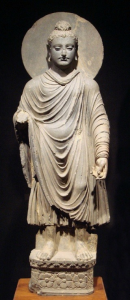 The following Vedic Civilization (approximately 1500 – 500 BC) characterized by Indo-Aryan culture, laid the foundations of Hinduism. Buddhism or rather unique Buddhist civilization took root here some 2500 years ago. Moreover, its main international centers were in the Pakistan region, i.e. Gandhara, Taxila, Swat valley, laid along the Silk Road between China and the Mediterranean. Their stone sculpture works where Greek and Buddhist customs mixed were extraordinary examples of ancient globalization and uniting of the West and the East. Greco-Buddhist art developed here over a period of 1000 years, roughly between the conquests of Alexander the Great in the 4th century BC and the Islamic conquests of the 7th century AD. The first representations of the Buddha in human form were created in Gandhara. They have set the artistic and sculptural canon for Buddhist art up to the present. To some extent, there is a spiritual link between Buddhist Gandhara and Mahatma Gandhi who was keen on non-violence.
The following Vedic Civilization (approximately 1500 – 500 BC) characterized by Indo-Aryan culture, laid the foundations of Hinduism. Buddhism or rather unique Buddhist civilization took root here some 2500 years ago. Moreover, its main international centers were in the Pakistan region, i.e. Gandhara, Taxila, Swat valley, laid along the Silk Road between China and the Mediterranean. Their stone sculpture works where Greek and Buddhist customs mixed were extraordinary examples of ancient globalization and uniting of the West and the East. Greco-Buddhist art developed here over a period of 1000 years, roughly between the conquests of Alexander the Great in the 4th century BC and the Islamic conquests of the 7th century AD. The first representations of the Buddha in human form were created in Gandhara. They have set the artistic and sculptural canon for Buddhist art up to the present. To some extent, there is a spiritual link between Buddhist Gandhara and Mahatma Gandhi who was keen on non-violence.
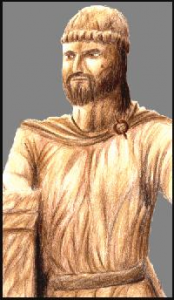 Peshawar was the place where the army of Alexander the Great stopped and refused to go any further, except for home. Peshawar is the oldest city in Pakistan and one of the oldest in South Asia. It was the capital of Kanishka the Great who ruled in the 2nd century AD and was presumably from the Sakas. This emperor of the Kushan dynasty was famous for his military, political, and spiritual achievements. His conquests and patronage of Buddhism played an important role in the development of the Silk Road and the transmission of Buddhism from the above mentioned Buddhist center Gandhara to China.
Peshawar was the place where the army of Alexander the Great stopped and refused to go any further, except for home. Peshawar is the oldest city in Pakistan and one of the oldest in South Asia. It was the capital of Kanishka the Great who ruled in the 2nd century AD and was presumably from the Sakas. This emperor of the Kushan dynasty was famous for his military, political, and spiritual achievements. His conquests and patronage of Buddhism played an important role in the development of the Silk Road and the transmission of Buddhism from the above mentioned Buddhist center Gandhara to China.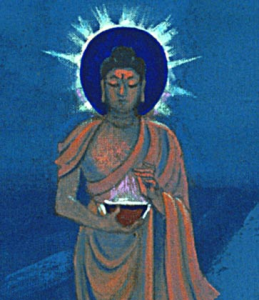
Kanishka the Great is credited with bringing to Peshawar (Puruṣapura) the bowl of Buddha from Vaishali in the modern Indian state Bihar (homeland of Buddhism and Jainism). Kanishka built at Peshawar a monumental stupa to house Buddhist relics. It is considered to be the tallest buildings in the ancient world and one if its wonders.
Peshawar is located on the same parallel (34°N) as the famous Buddhas of Bamiyan (Afghanistan), the tallest and the most gigantic in the whole world.  The statues and the surrounding cultural landscape are listed by UNESCO as a World Heritage Site. Madam Blavatsky (1831 — 1891) mentioned them in her Secret Doctrine. These statues represent five root races of mankind and their decrease in physical size. The first and largest statue was about 53 meters. The last of them is only slightly more than the average high man of our present race. The first two root races had ethereal bodies. The latter got physical ones. The third (~18 m.) and the forth (~8 m.) statues consequently represent the legendary Lemurians and Atlanteans. The statues were made in the image Buddha in our era by the monks.
The statues and the surrounding cultural landscape are listed by UNESCO as a World Heritage Site. Madam Blavatsky (1831 — 1891) mentioned them in her Secret Doctrine. These statues represent five root races of mankind and their decrease in physical size. The first and largest statue was about 53 meters. The last of them is only slightly more than the average high man of our present race. The first two root races had ethereal bodies. The latter got physical ones. The third (~18 m.) and the forth (~8 m.) statues consequently represent the legendary Lemurians and Atlanteans. The statues were made in the image Buddha in our era by the monks.
Akbar the Great (1542 — 1605) is credited with giving Peshawar its present name. Peshawar’s Sanskrit name, i.e. Puruṣapura and is interesting enough. Puruṣapura literally means ‘city of men’. The literal translation from the Russian of the Urals’ highest point is the mountain of men or people. It has direct name link with Vedic sage Narada.
Peshawar (Puruṣapura) region is also found mention in the Zend Avesta as the seventh most beautiful place on earth created by Ahura Mazda. In the ancient Zoroastrian scriptures of the Avesta, Hara Berezaiti is the most sacred mountain around which the stars and planets revolve. In Avestan cosmogony, Hara Berezaiti surrounded by the steppes of the Airyanem Vaejah that is the homeland of the Aryans.
Hara Berezaiti is associated with legendary Mount Meru in Hindu, Jain and Buddhist mythology. Surely, it appears to have been both a physical mountain as well as a metaphysical one.
The Northern Ridge (Severnyye Uvaly) in Vologda region of Russia is a strong candidate for the initial home of the Aryans and the most sacred place of their legends. It is a chain of hills approximately 200 km. long that divides the river basins of the Northern Dvina River (north) and the Volga River (south). It includes the source of the Kama River on the east. Among the principal rivers which have their source in the Northern Ridge is the Yug. Their names are not translated from the modern Russian, but rather from Sanskrit.
Adjacent settlements with Russified names Harino and Berezovo still exist near the highest point of the Northern Ridge. Compare them to Hara Berezaiti from the Avesta. The special peaks of Hara Berezaiti are called tara. Tara and nearby Agra are the river in Vladimir region of Russia that has ancient links with India or vice verse.
